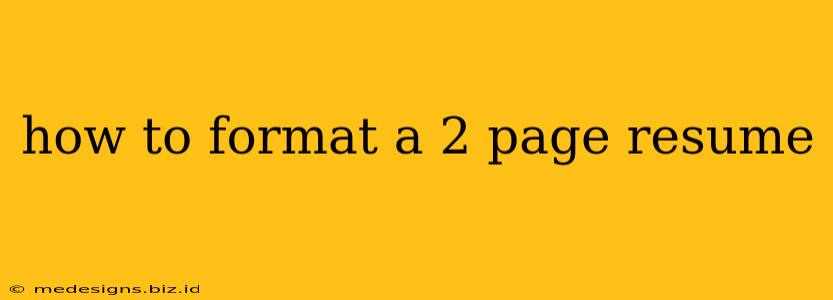How to Format a Two-Page Resume: A Comprehensive Guide
Landing your dream job often hinges on a compelling resume. While one page is ideal, sometimes two pages are necessary to showcase a robust career history, especially for seasoned professionals or those with diverse experiences. This guide will walk you through formatting a two-page resume that's both professional and effective.
Why Two Pages Might Be Necessary:
- Extensive Experience: More than 10-15 years of experience often requires more space.
- Career Changes: Demonstrating a successful transition between industries or roles needs detailed explanations.
- Significant Accomplishments: Extensive achievements warrant dedicated space for impactful descriptions.
- Academic Achievements: Advanced degrees, publications, or significant research projects may necessitate extra space.
Key Formatting Principles for a Two-Page Resume:
1. Consistent Formatting is Crucial:
- Font: Use a professional, easy-to-read font like Times New Roman, Arial, or Calibri (10-12 point). Maintain consistency throughout both pages.
- Margins: Use standard 1-inch margins on all sides. This ensures ample white space and readability.
- Spacing: Use consistent spacing between sections and bullet points. Avoid excessive spacing which can look unprofessional.
- Headers and Footers: Include your name and contact information in a header on both pages for easy reference. Page numbers in a footer are essential.
2. Organize Information Strategically:
- Page One Dominance: The most impactful information (summary/objective, key skills, and most recent experience) should be on page one. This creates a strong first impression.
- Logical Flow: Maintain a logical progression of information across both pages. The transition between page one and two should be seamless. Avoid abruptly ending a section on page one.
- Section Headings: Use clear and concise section headings (e.g., Summary, Experience, Education, Skills). This enhances readability and allows recruiters to quickly find relevant information.
3. Content Optimization for Both Pages:
- Prioritize Information: Only include relevant and impactful information. Avoid filler content. Focus on quantifiable achievements whenever possible (e.g., "Increased sales by 15%").
- Action Verbs: Start each bullet point with a strong action verb (e.g., managed, developed, implemented, achieved).
- Keywords: Incorporate relevant keywords from the job description throughout your resume. This will help your resume get noticed by Applicant Tracking Systems (ATS).
- Tailor to the Job: Customize your resume for each job application, highlighting the skills and experiences most relevant to the specific role.
4. Visual Appeal and Readability:
- White Space: Utilize white space effectively to break up large blocks of text and improve readability.
- Bullet Points: Use bullet points to make information easily scannable.
- Bolding and Italics: Use these sparingly to highlight key terms and achievements, avoid overuse.
Example of a Two-Page Resume Structure:
Page One:
- Contact Information: (Name, Phone Number, Email, LinkedIn Profile URL)
- Summary/Objective: (A brief overview of your skills and career goals)
- Key Skills: (Highlight your most relevant and marketable skills)
- Experience: (Your most recent and relevant work experience, with quantifiable achievements)
Page Two:
- Experience (continued): (Older work experience or further details on experience from page one)
- Education: (Degrees, certifications, relevant coursework)
- Awards and Recognition: (Significant accomplishments and accolades)
- Projects: (Significant personal or academic projects)
- Volunteer Experience (Optional): (If relevant to the job application)
Important Considerations:
- File Format: Use a PDF to ensure consistent formatting across different devices.
- Proofreading: Carefully proofread your resume for any errors in grammar, spelling, or punctuation.
- Seek Feedback: Ask a friend, career counselor, or mentor to review your resume before submitting it.
By following these guidelines, you can create a professional and effective two-page resume that highlights your skills and experience, increasing your chances of landing your dream job. Remember, while two pages might be necessary, strive for conciseness and impact in every word. Good luck!
